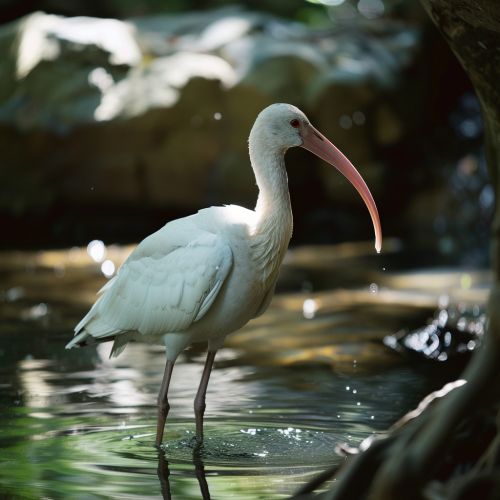The Ibis
Introduction
The Ibis is a group of long-legged wading birds in the family Threskiornithidae. These birds are known for their distinctive long, down-curved bills and are found in a variety of habitats, including wetlands, marshes, and coastal regions. The family Threskiornithidae includes both ibises and spoonbills, with ibises being more numerous and widespread.
Taxonomy and Classification
The family Threskiornithidae is part of the order Pelecaniformes, which also includes pelicans, herons, and egrets. The family is divided into two subfamilies: Threskiornithinae (ibises) and Plataleinae (spoonbills). There are approximately 29 species of ibises, which are further classified into several genera, including Threskiornis, Plegadis, and Eudocimus.
Morphology and Anatomy
Ibises are medium to large-sized birds, with body lengths ranging from 55 to 75 cm and wingspans of 80 to 120 cm. They have long, slender legs adapted for wading through shallow water and mud. The most distinctive feature of ibises is their long, down-curved bill, which they use to probe for food in the substrate.


The plumage of ibises varies widely among species, ranging from pure white to glossy black, with some species exhibiting iridescent colors. Sexual dimorphism is generally minimal, with males and females appearing similar in size and coloration.
Habitat and Distribution
Ibises are found on every continent except Antarctica, with the highest diversity in tropical and subtropical regions. They inhabit a wide range of wetland environments, including freshwater and saltwater marshes, swamps, riverbanks, and coastal lagoons. Some species, such as the Sacred Ibis (Threskiornis aethiopicus), are highly adaptable and can be found in urban areas and agricultural fields.
Behavior and Ecology
Ibises are social birds that often form large flocks, especially during the breeding season. They are diurnal and spend most of their day foraging for food. Their diet consists primarily of small aquatic animals, such as fish, crustaceans, insects, and mollusks. Some species also consume plant material, including seeds and algae.
Ibises use their long bills to probe into the mud and water to locate prey. They have sensitive tactile receptors in their bills that help them detect and capture food. Some species, like the Glossy Ibis (Plegadis falcinellus), are known to feed cooperatively, with individuals working together to herd fish into shallow water.
Reproduction and Lifespan
Ibises are monogamous and typically form long-term pair bonds. They build their nests in colonies, often in trees or shrubs near water. The nests are constructed from sticks and vegetation and are lined with softer materials. The female usually lays 2 to 4 eggs, which are incubated by both parents for about three weeks.
The chicks are altricial, meaning they are born helpless and require significant parental care. Both parents feed the chicks by regurgitating food. The young fledge after about six weeks but remain dependent on their parents for several more weeks. The lifespan of ibises in the wild is typically around 15 to 20 years, although some individuals have been known to live longer.
Conservation Status
The conservation status of ibises varies widely among species. Some species, like the White Ibis (Eudocimus albus), are abundant and have stable populations. Others, such as the Northern Bald Ibis (Geronticus eremita), are critically endangered due to habitat loss, hunting, and other human activities.
Conservation efforts for endangered ibis species include habitat protection, captive breeding programs, and reintroduction initiatives. International cooperation and legal protection are also crucial for the conservation of migratory species that cross national borders.
Cultural Significance
Ibises have held cultural significance in various human societies throughout history. In ancient Egypt, the Sacred Ibis was venerated and often depicted in art and hieroglyphs. The bird was associated with Thoth, the god of wisdom and writing. Mummified ibises have been found in large numbers in Egyptian tombs, indicating their importance in religious rituals.
In other cultures, ibises are seen as symbols of purity, vigilance, and resourcefulness. Their presence in wetlands is often considered an indicator of a healthy ecosystem.
See Also
References
- del Hoyo, J., Elliott, A., & Sargatal, J. (Eds.). (1992). Handbook of the Birds of the World, Vol. 1: Ostrich to Ducks. Lynx Edicions.
- Matheu, E., & del Hoyo, J. (1992). Family Threskiornithidae (Ibises and Spoonbills). In J. del Hoyo, A. Elliott, & J. Sargatal (Eds.), Handbook of the Birds of the World, Vol. 1: Ostrich to Ducks. Lynx Edicions.
- Kushlan, J. A., & Hancock, J. A. (2005). The Herons. Oxford University Press.
